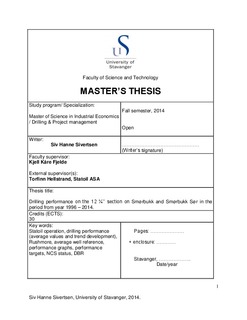| dc.contributor.author | Sivertsen, Siv Hanne | |
| dc.date.accessioned | 2015-12-04T12:31:25Z | |
| dc.date.available | 2015-12-04T12:31:25Z | |
| dc.date.issued | 2014-12-01 | |
| dc.identifier.uri | http://hdl.handle.net/11250/2367015 | |
| dc.description | Master's thesis in Industrial economics | nb_NO |
| dc.description.abstract | The cost of drilling wells at the Norwegian Continental Shelf (NCS) has increased drastically. This is one of the focal points both in the media and for the operating companies when it comes to the future of the NCS. For Statoil it is crucial to disclose a reason for increased time consumption on drilling operations. To be able to achieve this, a quantitative breakdown and analysis of the operations on a drilling section must be performed.
This thesis aims to identify and quantify the operations contributing to the diminished performance on the selected fields Smørbukk and Smørbukk Sør in the Norwegian Sea. The time period spans from year 1996 to 2014 and all the 58 12 ¼’’ sections drilled are included. The fraction of time spent on the 12 ¼’’ drilling section is somewhat above one third of the total time spent on all of the drilling sections. A higher efficiency in this drilling section will have a high impact on the cost effectiveness and the ability to deliver a well faster.
The data set has been divided into two intervals, Interval 1 and Interval 2. This is due to a two year drilling break from year 2002 – 2004. Interval 1 is before the drilling break and interval 2 is after.
It is difficult to identify exactly what is the reason for the increased amount of time spent on drilling wells. To be able to analyze the data all the operations in the 12 ¼’’ section were extracted from the drilling reporting system (DBR) and carefully categorized manually. The development of the drilling performance has been investigated and visualized utilizing several different approaches;
Displaying the average percentage time distribution on operations in both Interval 1 and Interval 2 by use of pie charts
Quantify the average change in the time distribution between the two intervals
Showing the change in the trend of the long time performance development for the total time period
Comparing the performance in the end of both intervals
Showing the learning and batch drilling effects in Interval 1
Outline of the performance of the rigs working on the fields in Interval 1 and 2
The analysis revealed that there was a clear improvement in the drilling and circulation performance itself, but all of the other operations done in the section are contributing towards a declined total performance. Some of the key findings were:
The average time spent on the 12 ¼’’ section in Interval 2 has increased by 39,09 hours.
Interval 1 was a period of steady improvement and positive development. In the end of the period the performance was at an all-time high.
Interval 2 started off at a lower point with regards to performance. There was a decline in performance on all operations from the end of Interval 1 to the start of Interval 2. The good performance gained from learning effects, knowledge
IV
Siv Hanne Sivertsen, University of Stavanger, 2014.
transfer and frequently drilled wells were lost when operations resumed in Interval 2.
Average downtime percentage has increased from 8,8 % in the first interval to 13,6 % in the latter.
To assure improved drilling performance in the future the effect of batch drilling and continuous operation should not be underestimated. If there is a possibility for having more than one rig drilling at the same time this can provide a competitive environment and synergies with regards to knowledge transfer.
Microsoft Excel has been used as a tool for analysis of the data and the graphs presented in this study. In addition Statoil’s reporting system (DBR) and its automated extracts have been utilized. All of the background material is added as appendices in ‘Appendix B - Breakdown of operations of all wells analyzed’. | nb_NO |
| dc.language.iso | eng | nb_NO |
| dc.publisher | University of Stavanger, Norway | nb_NO |
| dc.rights | Navngivelse-Ikkekommersiell-IngenBearbeidelse 3.0 Norge | * |
| dc.rights.uri | http://creativecommons.org/licenses/by-nc-nd/3.0/no/ | * |
| dc.subject | Statoil operation | nb_NO |
| dc.subject | Rushmore | nb_NO |
| dc.subject | average well reference | nb_NO |
| dc.subject | performance graphs | nb_NO |
| dc.subject | performance targets | nb_NO |
| dc.subject | NCS status | nb_NO |
| dc.subject | DBR | nb_NO |
| dc.subject | industriell økonomi | nb_NO |
| dc.subject | drilling performance | nb_NO |
| dc.title | Drilling performance on the 12 1/4'' section on Smørbukk and Smørbukk Sør in the period from year 1996 - 2014 | nb_NO |
| dc.type | Master thesis | nb_NO |
| dc.subject.nsi | VDP::Social science: 200::Economics: 210::Economics: 212 | nb_NO |
| dc.source.pagenumber | 69 | nb_NO |

